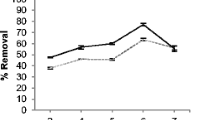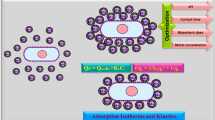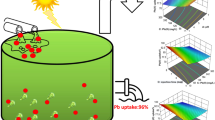Abstract
The present work investigated the ability of inactive brown seaweed, Turbinaria conoides, to biosorb aluminum(III) and cadmium(II) ions in both single and binary systems. Initial experiments were undertaken to determine the influence of pH and biosorption isotherms of each metallic ion. Owing to the presence of carboxylic groups, T. conoides exhibited high uptake capacity towards Al(III) and Cd(II) through ion-exchange mechanism. In the case of Al(III), T. conoides exhibited maximum biosorption at pH 4 with a capacity of 2.37 mmol/g, whereas the highest Cd(II) biosorption occurred at pH 5 with a capacity of 0.96 mmol/g. For both metal ions, T. conoides exhibited fast kinetics. Several models were used to describe isotherm (Langmuir, Freundlich, Redlich-Peterson, and Toth) and kinetic (pseudo-first and pseudo-second order) data. Desorption and reuse of T. conoides biomass in three repeated cycles was successful with 0.1 M HCl as elutant. In binary systems, the presence of Cd(II) severely affected Al(III) uptake by T. conoides. Compared to single-solute systems, Al(III) uptake was reduced to 56% compared to only 27% for Cd(II). Based on the model parameters regressed from the respective monometal systems, multicomponent Langmuir and Freundlich models were used to predict binary (Al + Cd) system of which the multicomponent Freundlich model was able to describe with good accuracy.




Similar content being viewed by others
References
Choy, K. K. H., Porter, J. F., & McKay, G. (2000). Langmuir isotherm models applied to the multicomponent sorption of acid dyes from effluent onto activated carbon. Journal of Chemical Engineering Data, 45, 575–584.
Davis, T. A., Volesky, B., & Mucci, A. (2003). A review of the biochemistry of heavy metal biosorption by brown algae. Water Research, 37, 4311–4330.
Du, A. L., Dive, D., & Philippo, A. (1990). Interaction between components of electroplating industry wastes. Influence of the receiving water on the toxicity of the effluent. Environmental Pollution, 65, 251–267.
Kratochvil, D., & Volesky, B. (2000). Multicomponent biosorption in fixed beds. Water Research, 34, 3186–3196.
Kuyucak, N., & Volesky, B. (1989). Desorption of cobalt-laden algal biosorbent. Biotechnology and Bioengineering, 33, 815–822.
McKay, G., & Al-Duri, B. (1987). Simplified model for the equilibrium adsorption of dyes from mixtures using activated carbon. Chemical Engineering and Processing, 22, 145–156.
Meiri, H., Banin, E., Roll, M., & Rousseau, A. (1993). Toxic effects of aluminium on nerve cells and synaptic transmission. Progress in Neurobiology, 40, 89–121.
Nassar, N. N. (2011). Kinetics, equilibrium and thermodynamic studies on the adsorptive removal of nickel, cadmium and cobalt from wastewater by superparamagnetic iron oxide nanoadsorbents. The Canadian Journal of Chemical Engineering. doi:10.1002/cjce.20613.
Romero-Gonzalez, M. E., Williams, C. J., & Gardiner, P. H. E. (2001). Study of the mechanisms of cadmium biosorption by dealginated seaweed waste. Environmental Science and Technology, 35, 3025–3030.
Sağ, Y., Akçael, B., & Kutsal, T. (2001). Evaluation, interpretation, and representation of three-metal biosorption equilibria using a fungal biosorbent. Process Biochemistry, 37, 35–50.
Sheindrof, C., Rebhun, M., & Sheintuch, M. A. (1981). Freundlich type multicomponent isotherm. Journal of Colloid and Interface Science, 79, 136–142.
USEPA. (2011). 2011 edition of the drinking water standards and health advisories. Washington DC.
USEPA. (2009). 2009 U.S. Environmental Protection Agency (USEPA) National recommended water quality criteria, Office of Water, Office of Science and Technology, Washington DC 4304T.
Verougstraete, V., Lison, D., & Hotz, P. (2002). A systematic review of cytogenetic studies conducted in human populations exposed to cadmium compounds. Mutation Research, 511, 15–43.
Vijayaraghavan, K., & Balasubramanian, R. (2010). Single and binary biosorption of cerium and europium onto crab shell particles. Chemical Engineering Journal, 163, 337–343.
Vijayaraghavan, K., Palanivelu, K., & Velan, M. (2006a). Biosorption of copper(II) and cobalt(II) from aqueous solutions by crab shell particles. Bioresource Technology, 97, 1411–1419.
Vijayaraghavan, K., Palanivelu, K., & Velan, M. (2006b). Treatment of nickel containing electroplating effluents with Sargassum wightii biomass. Process Biochemistry, 41, 853–859.
Vijayaraghavan, K., & Yun, Y.-S. (2008). Bacterial biosorbents and biosorption. Biotechnology Advances, 26, 266–291.
Vinod, V. P., & Anirudhan, T. S. (2003). Adsorption behavior of basic dyes on the humic acid immobilized pillared clay. Water Air and Soil Pollution, 150, 193–217.
Volesky, B. (2001). Detoxification of metal-bearing effluents: Biosorption for the next century. Hydrometallurgy, 59, 203–216.
Volesky, B., & Holan, Z. R. (1995). Biosorption of heavy metals. Biotechnology Progress, 11, 235–250.
Acknowledgment
The author gratefully acknowledges the support and contributions of the Singapore-Delft Water Alliance (SDWA) to this project.
Author information
Authors and Affiliations
Corresponding author
Rights and permissions
About this article
Cite this article
Vijayaraghavan, K., Gupta, S. & Joshi, U.M. Comparative Assessment of Al(III) and Cd(II) Biosorption onto Turbinaria conoides in Single and Binary Systems. Water Air Soil Pollut 223, 2923–2931 (2012). https://doi.org/10.1007/s11270-012-1075-y
Received:
Accepted:
Published:
Issue Date:
DOI: https://doi.org/10.1007/s11270-012-1075-y




